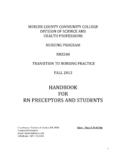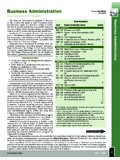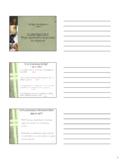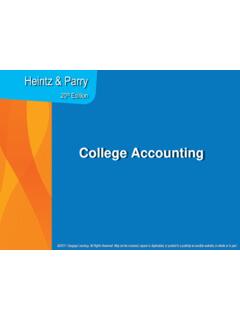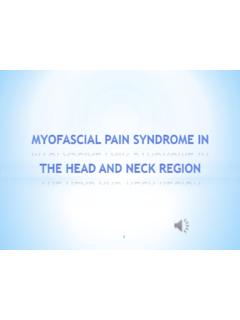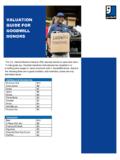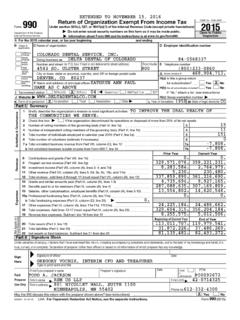Transcription of Accounting for the Business- Type Activities of …
1 Copyright 2010 by The McGraw-Hill Companies, Inc. All rights reserved. McGraw-Hill/IrwinChapter7 Accounting for the Business- Type Activities of State and Local Governments7-2`Learning ObjectivesAfter studying Chapter 7, you should be able to: Distinguish between the purposes of internal service funds and enterprise funds Describe the characteristics of proprietary funds, including those unique to internal service and enterprise funds7-3 Learning Objectives (Cont d) Explain the financial reporting requirements, including the differences between the reporting of internal service and enterprise funds in the government-wide and fund financial statements Describe Accounting procedures and prepare journal entries and financial statements for an internal service fund Describe Accounting procedures and prepare journal entries and financial statements for an enterprise fund7-4 Reasons for use Enhances management of Activities in which goods or services are provided on a cost-reimbursement basis to departments of the same government or to the general public on a user charge basis To compare benefits and costs of the Business- type Activities of agovernmentProprietary
2 Funds7-5 Assets -Liabilities = Net AssetsProprietary FundsAccounting EquationUnrestrictedRestricted ( , for payment of debt service)Invested in Capital Assets, Net of Related Debt7-6 Use accrual basis Capital assets and long-term liabilities recorded within the funds Flexible rather than fixed budgets recommended; generally budgetary accounts are not integrated into the general ledger Depreciation expense and accumulated depreciation are recorded and reported For Accounting guidance look to Accounting procedures used by similar type private enterprises Proprietary Funds Accounting Characteristics7-7 Proprietary Funds Required Financial StatementsSimilar to those of a for-profit entity.
3 Statement of net assets (or balance sheet) Statement of revenues, expenses, and changes in fund net assets (operating statement) Statement of cash flows (differs under GASB)7-8 Proprietary Funds Statement of Net Assets A classified statement is prepared, with current assets shown in the order of liquidity Net assets are divided into three categories Invested in capital assets, net of related debt calculated as the value of net capital assets less any outstanding debt related to capital asset acquisitions or construction Restricted restrictions are placed on asset use by external parties through contracts, legal requirements, or donor stipulation Unrestricted the residual after adjusting for the preceding two net asset categories7-9 Proprietary Funds Operating Statement GASB requires that revenues and expenses be identified as operating or non-operating Operating Activities relate to the primary functions of the proprietary fund Separate subtotals are to be provided for operating information7-10 Similaritiesbetween GASB and FASB standards.
4 Cash flows statement shows cash inflows/outflows relating to operating, financing, and investing Activities Both sets of standards define cash flows as cash and cash equivalents ( , time deposits, marketable securities, and other items readily convertible to cash)Proprietary Funds Statement of Cash Flows7-11 Differencesbetween GASB and FASB standards: GASB cash flow statement divides financing Activities into noncapital, and capital and related financing Acquisition of capital assets is a capital and related financing transaction under GASB rather than an investing activity Interest expense on long-term debt is a capital and related financing activity under GASB rather than an operating activity Cash flows from operating Activities must be shown using the direct methodProprietary Funds Statement of Cash Flows (Cont d)
5 7-12 Used When authorized by legislative approval To account for provision of goods and services to departments of the same government generally on a cost reimbursement basis To improve management of common resources by placing them under centralized management and controlInternal Service Funds7-13 Motor pools Central purchasing Storage Issuance of supplies Self-insurance pools Central data processing PrintingCommon types of internal Service Funds7-14 Pricing is set by local management or by legislative policy Pricing objectives vary; full cost recovery (direct and indirect), direct cost recovery, or whatever management desiresBecause legislative bodies do not want purchasing to occur outside the budget, the bodies are sometimes reluctant to establish internal service fundsQ: Is the legislative concern justified?
6 internal Service Funds Pricing Policies7-15Q/A: Is the legislative concern justified? Even if an internal service find is created for central purchasing and sales of supplies, the legislative body maintains budgetary control over the expenditures made by most departments and programs via the General Fund and special revenue funds budgets See and discuss Illustration 7-1 internal Service Funds Pricing Policies (Cont d)7-16 Generally, use the same Accounting procedures that a similar for-profit entity would use. (Review illustrative transactions in the text for a supply fund and compare to business Accounting ) Billings to Departments is a revenue account, similar to Sales in a for-profit entity Revenues and expenses are closed at year-end to Excess of Net Billings to Departments over Costs (or Excess of Costs over Net Billings to Departments) rather than to Income Summary internal Service Funds Accounting Procedures7-17 Other than slight differences in terminology, the fundfinancial statements are essentially the same asthose of a comparable for-profit entity Statement of net assets (see Ill.)
7 7-2) Statement of revenues, expenses, and changes in fund net assets (see Ill. 7-3) Statement of cash flows (see Ill. 7-4) internal Service Funds Financial Statements7-18 internal Service Funds External Reporting internal service funds are aggregated and reported in a separate column in the proprietary fund financial statements (see Ill. A1-7 through A1-9) internal service funds are never considered major funds In the government-wide financial statements, internal service funds are reported as a part of the governmental Activities column interfund activity between internal service funds and governmental funds must be eliminated7-19If a government uses an internal service fund (ISF) for a risk management (self-insurance) pool: The ISF should recognize claims expense and a related liability when.
8 It is probable that an asset has been impaired or a liability has been incurred and the amount is reasonably estimable, or if an estimable loss has been incurred and it is probable that a claim will be asserted Disclose other loss contingencies in the notes internal Service Fund Risk Management7-20 Transfer ISF assets to another fund that will continue the activity Terminate activity and distribute assets in-kind to another fund or funds Convert ISF assets to cash and distribute cash to another fund or fundsInternal Service Fund Dissolving a Fund7-21 Reasonsforuse: WhenGASB standardsrequire Toaccountforservicesprovidedtothegeneral publiconauserchargebasis When the governing body has determined that periodic determination of revenues earned, expenses incurred, and/or net income is appropriate for capital maintenance, public policy, management control, accountability, or other purposesEnterprise Funds7-22 Enterprise FundsGASB requires use of an enterprise fund if thefollowing criteria are met.
9 An activity is financed with debt that is secured solely with revenues from the activity Law or regulation requires that the costs of the activity, including capital costs, be recovered with revenue from the activity, rather than taxes or other revenues7-23 Common types of Enterprise Funds Water and sewer Gas and electric utilities Transportation systems Airports Ports Toll roads and bridges Parking garages and lots Golf courses Hospitals Liquor stores7-24 GASB standards provide guidance on Business- type Activities However, GASB also requires that proprietary funds follow pronouncements of the FASB and its predecessors issued before November 30, 1989, unless they conflict with a GASB standard Additionally, enterprise funds may optto follow all FASB and predecessor standards that pertain to businesses, both those issued before and after November 30, 1989, unless the standard conflicts with a GASB standardEnterprise Funds Accounting Procedures7-25 Assets whose use is restricted by contractual agreements or legal requirements Typical examples.
10 Customer deposits of utilities, assets set aside for repayment of revenue bond principal, reserves for maintenance of plant, and funding of depreciation Although notrequired by GAAP, ideally liabilities to be paid from restricted assets should be reported separately from liabilities to be paid from unrestricted assets (see next slide) Enterprise Funds Restricted Assets7-26 Enterprise Funds Restricted Assets (Cont d)Restricted AssetsLiabilities Payable from Restricted Assets+ Net Assets, Restricted for Payment of Debt ServiceFrom Illustration7-5$562,600$23,700 + $538,900==7-27Q:Should interest incurred on debt during construction be capitalized?A: Yes. Notice that this policy differs from the interest capitalization policy for self-constructed general capital assetsEnterprise Funds Utility Plant Construction in Progress7-28Q:Should an imputed amount equivalent to interest be capitalized if a utility s own funds are used for construction?
